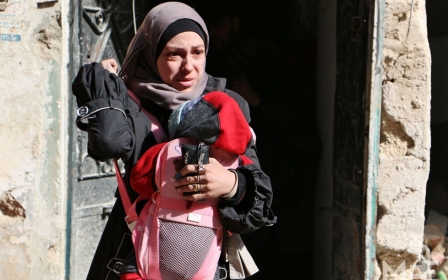The shadow of IS has fallen across Yarmouk

News that fighters from the Islamic State (IS) had entered Yarmouk refugee camp in southern Damascus on Wednesday morning sent shockwaves around the world.
Yarmouk, a once-thriving Damascus suburb home to 150,000 Palestinian refugees and Syrians, has been under siege by government forces for more than a year.
In 2014 the camp entered the world’s consciousness when a local photographer took a picture of hundreds of men and women queuing for food in a street lined with destroyed buildings.
As well as hunger, lack of water and electricity, residents of Yarmouk are now confronted by violent militants who have captured large parts of Syria and Iraq.
But while IS has only recently entered Yarmouk - five miles from the center of the capital - the group has, according to local journalists and residents, been active in southern Damascus for months.
On Wednesday Middle East Eye spoke to Ahmad (not his real name), a 30-year-old journalist and activist inside Yarmouk camp, about how IS had come within striking distance of the Syrian capital.
What happened today? How did IS enter Yarmouk?
Islamic State fighters entered Yarmouk camp this morning from the southern neighbourhood of Hajr al-Aswad. Gun battles between IS fighters and a Palestinian armed group called Aknaf Beit al Maqdis ensued, while the Syrian government bombed the camp with mortar shells from above.
Who are these Islamic State fighters? Are they foreigners or Syrians?
Most of the fighters of IS are not foreigners; they are sons of southern Damascus. IS did not come from nowhere. It was born out of the siege. Last year when food and water were running out and electricity was dwindling, support for IS began to grow. When IS first emerged in July 2014, people saw positive outcomes. They stopped corruption. They ensured that people had food and drink. But they soon diverged from that path and become more violent, more extreme. They began to impose their own ideology as opposed to caring about what the people actually wanted.
Where did IS first emerge in Damascus? How did they get to Yarmouk?
IS first emerged in early 2014 in Hejirah, a neighbourhood in southeast Damascus that is home to the Zainab moque, a holy Shiite shrine. After fighting Shiite militias, mainly Hezbollah, they were pushed out of Hejira by regime forces. After that, IS moved to a place called Yalda where they fought gun battles with the Free Syrian Army (FSA). Their latest enclave is the neighbourhood of Hajr al-Aswad, which is right next to Yarmouk camp. Since last year IS has been moving steadily north-east toward central Damascus.
If much of southern Damascus is under siege by Syrian government forces, how are IS able to move?
Here in southern Damascus we are under siege but there are six or seven neighbourhoods that are linked to each other. It is possible to move from one to another, like moving from island to island. This is what southern Damascus is like. The Islamic State is now in Hajar al-Aswad but they can easily transfer fighters to other areas.
It seems as though IS has been fighting other rebel groups. Why?
We know that Jubat al-Nusra (an offshoot of al-Qaeda) is in opposition to IS. But two weeks ago al-Nusra was in a battle with elements of the FSA and IS did not intervene. When there is infighting between rebel groups, the others don’t take sides.
What is the effect of this infighting?
The priority is to fight the regime and end the blockade but unfortunately that priority gets lost amongst these parties. The number one victims are civilians. Today a colleague of mine, Jamal Khalifa, was killed. Today a mortar shell fell in the road behind my house.
What are living conditions like inside Yarmouk?
Rebel groups are fighting each other instead of fighting the regime, who shell us every day. Meanwhile there is no electricity, no food, no cellphone coverage. The shelves in my kitchen are empty. I can’t buy anything because there is nothing in the shops to buy. My condition is comparably better than others. Residents used to go to soup kitchens for food but since a curfew was enforced no one goes out. The situation is disastrous. We get our water from wells. We can’t use cars so we go by feet and risk getting shot by snipers. We cannot help the injured. We don’t know what the aim of the rebels is anymore ... is it to control the camp, defeat the regime? Get rid of another rebel group?
Stay informed with MEE's newsletters
Sign up to get the latest alerts, insights and analysis, starting with Turkey Unpacked
Middle East Eye delivers independent and unrivalled coverage and analysis of the Middle East, North Africa and beyond. To learn more about republishing this content and the associated fees, please fill out this form. More about MEE can be found here.






